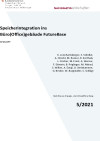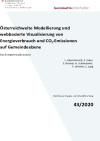Suchergebnisse
50 grüne Häuser - Entwicklung und Demonstration eines Low-Tech-Grünfassadensystems
Entwicklung einer kostengünstigen gewerke- und prozessübergreifenden All-In Gebäudebegrünung inkl. Wartungskonzept ("Greening-Toolkit") zur breiten (vor allem straßenseitigen) Implementierung auf Fassaden im städtischen Bestand, kombiniert mit einer Prozessinnovation zur Vereinfachung aller notwendigen Abstimmungsprozesse.
Analysis of the high-quality wooden facade in extreme climates
The project "Alpine base Schiestlhaus on the Hochschwab, which was opened in 2005, represents a lighthouse project for the "House of the Future" programme as the 1st shelter in zero-energy house quality. After more than 15 years in operation, however, damages came to light. Within the framework of this project, analysis activities were carried out on the cause of damage as well as the development of new facade structures.
Monitoring Sunhouse Eferding
In course of the monitoring project the effectiveness of the energy-technical system was checked on the basis of running measuring data. The data were evaluated and, if required, the arrangements and settings of the control system were adapted. Main result is that the energy balance could have been improved explicitly whilst the monitoring process.
SmallWindPower@Home - Impact assessment of building-mounted small wind turbines on performance, people, building and environment
Within the project SmallWindPower@Home the impact of complex obstacles on the local flow pattern as well as on the inflow and the performance of different building-mounted small wind turbines (SWT) had been evaluated. Furthermore the effects of these building-mounted SWT on the building, the resident people and the direct environment were analysed.
SmallWindPower@Home - Evaluierung der Auswirkungen von gebäudemontierten Kleinwindenergieanlagen auf Performance, Personen, Gebäude und Umgebung
Im Projekt „SmallWindPower@Home“ erfolgte eine messtechnische Evaluierung der Auswirkungen von komplexen Hindernissen auf die Anströmung und Performance unterschiedlicher gebäudemontierter Kleinwindenergieanlagen (KWEA). Darüber hinaus wurden deren Auswirkungen auf das Gebäude, dessen Bewohner und die unmittelbare Umgebung untersucht.
Monitoring Sonnenhaus Eferding
Im Monitoringprojekt wurde die Funktionsfähigkeit der energietechnischen Anlage anhand von laufenden Messdaten überprüft. Die Daten wurden ausgewertet, evaluiert und bei Bedarf die Anlage und die Einstellungen der Steuerung und Regelung adaptiert. Hauptergebnis ist die deutliche Verbesserung der Energiebilanz im Verlauf des Monitoring-Prozesses.
Energiemosaik Austria - Österreichweite Modellierung und webbasierte Visualisierung von Energieverbrauch und CO2-Emissionen auf Gemeindeebene
Inhalt des Projektes ist eine alle Nutzungs- und Mobilitätsarten umfassende Modellierung und webbasierte Visualisierung von Energieverbrauch und Treibhausgasemissionen aller österreichischen Gemeinden. Die Ergebnisse können in zahlreiche energie- und klimarelevante Handlungsfelder integriert und für die Sensibilisierung von Entscheidungsträgern und Öffentlichkeit genutzt werden.
Energy Mosaic Austria - Austrianwide modelling and web-based visualisation of energy consumption and greenhouse gas emissions on local level
The project consists of a modelling and a web-based visualisation of energy consumption and greenhouse gas emissions of all Austrian cities and municipalities considering all kinds of land use and mobility. The results deliver a sound basis for numerous energy and climate relevant fields of action and for awareness raising of decision makers and the public.
PHOTOVOLTAIK-WATER-Solution
Passivhaussanierung mit fassadenintegrierten Photovoltaik-Modulen zur gleichstrombasierten Warmwasservorerwärmung. Die GIWOG, ein energiebewusster und ökologisch und sozial orientierter Bauherr, beabsichtigt bei der Wohnhausanlage Graz, Liebenauer Hauptstraße 302-306 eine energetischen Modernisierung mit weiteren Optimierungen zu effizienter Energienutzung durchzuführen. Ziel ist den Endenergieverbrauch für Warmwasser und Heizung von derzeit ca. 135 kWh/m²a auf ca. 8 kWh/m²a abzusenken. Durch die geplanten Maßnahmen soll eine Gesamtenergieverbrauchsreduktion von rd. 94 % erreicht werden.
PHOTOVOLTAIC WATER Solution
Passive House refurbishment facade with integrated photovoltaic modules for direct, current-based warm water preheating. The GIWOG, an energy-conscious and environmentally and socially oriented client, intends to undertake an energy-related modernisation project, which will further optimise energy consumption to be more efficient at an apartment complex in Graz, main street 302-306. The goal is to lower the energy consumption for heating and hot water from the current level of approximately 135 kWh /m²a to approximately 8 kWh /m²a. The planned measures should correspond with an overall energy consumption reduction of approx. 94 %.
Speicherintegration ins Büro(Office)gebäude FutureBase (SPIN.OFF)

Im vorliegenden Projektvorhaben wurde in ein - in Planung befindliches - Bürogebäude ein Zink-Bromid Redox Flow Batteriespeicher integriert. Anhand dieser Demonstrationsanlage können Fragen, die bei der Integration und dem Betrieb von Batteriespeichern in gewerblichen oder öffentlichen Gebäuden auftreten, beantwortet werden.
Schriftenreihe
5/2021
K. Leonhartsberger, S. Schidler, A. Hirschl, M. Rosner, R. Korthals, L. Fischer, M. Ernst, A. Werner, F. Ettwein, B. Priglinger, M. Meisel, S. Wilker, A. Estaji, O. Stelzhammer, G. Becker, W. Burgstaller, S. Schlägl
Herausgeber: BMK
Deutsch, 139 Seiten
Downloads zur Publikation
Energiemosaik Austria - Österreichweite Modellierung und webbasierte Visualisierung von Energieverbrauch und CO2-Emissionen auf Gemeindeebene

Inhalt des Projektes ist eine alle Nutzungs- und Mobilitätsarten umfassende Modellierung und webbasierte Visualisierung von Energieverbrauch und Treibhausgasemissionen aller österreichischen Gemeinden. Die Ergebnisse können in zahlreiche energie- und klimarelevante Handlungsfelder integriert und für die Sensibilisierung von Entscheidungsträgern und Öffentlichkeit genutzt werden.
Schriftenreihe
43/2020
L. Abart-Heriszt, S. Erker, S. Reichel, H. Schöndorfer, E. Weinke, S. Lang
Herausgeber: BMK
Deutsch, 56 Seiten
Downloads zur Publikation
Passivhaus Kierling - Der Zukunft nachhaltig entgegen
Am Beispiel der Demonstrationssanierung Kierling (errichtet zwischen 1977 und 1979) sollten bewusst die Möglichkeiten einer Passivhaussanierung in technischer, organisatorischer und auch finanzieller Hinsicht als herausragendes Beispiel für eine umfassende Sanierung erprobt werden.
e80^3-Buildings - Sub project 5: Monitoring and dissemination
The content of subproject 5 was the analysis of energy- as well as building-biology-related issues for the evaluation and quality management of the demo-project in Kapfenberg, which involves a high-quality refurbishment to a plus energy house within the program "Haus der Zukunft - Building of Tomorrow". Within this process the user acceptance before, during and after the renovation was elevated and this will be processed for upcoming projects. The environmental quality of the building regarding the choice of materials and measures during the construction phase and the subsequent use of the building was assessed with the help of the TQB-planning and evaluation tool.
Kierling passive house - heading into the future sustainably
Using the example of demonstrational renovation, Kierling (built between 1977 and 1979) tests the possibilities of a renovation in passive house standard in technical, organizational and financial terms as an outstanding example of a comprehensive renovation.
Gründerzeit with future - demonstration project 1: David´s Corner
High value energy efficient refurbishment of an ensemble of three neighbouring Wilhelminian style buildings in a non-lucrative location.
Gründerzeit mit Zukunft - Demonstrationsprojekt 1: David´s Corner
Energetisch hochwertige Sanierung von drei benachbarten gründerzeitlichen Wohnhäusern in ertragsschwacher Lage.
SmallWindPower@Home - Evaluierung der Auswirkungen von gebäudemontierten Kleinwindenergieanlagen auf Performance, Personen, Gebäude und Umgebung

Im Projekt „SmallWindPower@Home“ erfolgte eine messtechnische Evaluierung der Auswirkungen von komplexen Hindernissen auf die Anströmung und Performance unterschiedlicher gebäudemontierter Kleinwindenergieanlagen (KWEA). Darüber hinaus wurden deren Auswirkungen auf das Gebäude, dessen Bewohner und die unmittelbare Umgebung untersucht.
Schriftenreihe
10/2022
K.Leonhartsberger, A. Hirschl,S.Schidler, B. Priglinger, M. Peppoloni,D.Österreicher, K. Baumann-Stanzer,S.Stenzel, C. Lotteraner, T. Duer,K.Leeb, K. Strohkendl, C. Tiefgraber,A.Stökl, F. Lachinger
Herausgeber: BMK
Deutsch, 166 Seiten
Downloads zur Publikation
Energy Efficiency and Risk Management in Public Buildings (EnRiMa)
The major objective of the project EnRiMa was to develop an internet based decision-support system (DSS) to enable operators of public buildings to increase the system efficiency as well as to reduce the CO2 emissions. The DSS can be linked to existing energy management systems as DESIGOTM. The University of Applied Science Burgenland, Campus Pinkafeld, and ENERGYbase, Vienna, have been used to test and calibrate the EnRiMa DSS.
Energy Efficiency and Risk Management in Public Buildings (EnRiMa)
Das zentrale Ziel des EU Forschungsprojektes EnRiMa war es, ein internetbasierendes Entscheidungsfindungsprogramm (Decision Support System - DSS) zu entwickeln, das Betreiber von öffentlichen Gebäuden in der Effizienzsteigerung und CO2 Emissionsreduktion unterstützt. Das DSS wurde mit existierenden Gebäudeleitsystemen, wie DESIGOTM verknüpft und es wurden zwei österreichisches Testgebäude mit dem DSS analysiert. Ebenso wurde ein weiteres Testgebäude in Spanien untersucht.
